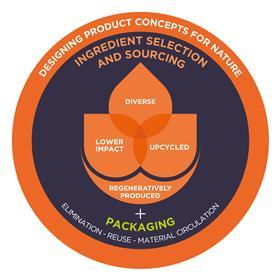Fast forward to 2030. Biscuit brand Sweet Up is showing how our food system can be designed with nature in mind. The story is fictional, but the potential for a circular design for food is very real.
When marketing manager Janine Smith thinks back 10 years, to the spring of 2020, she can’t quite believe what started one evening in her kitchen. During the first UK Covid lockdown, she read that a third of all food is wasted, and challenged herself to cook using what she’d usually throw into the bin. While chopping up some kale stems to add to a pesto sauce, she suddenly thought: “Why don’t we do this at work?”
It was a lightbulb moment that ended up transforming the fortunes of the food company Smith worked for: Great Oat Farms, a manufacturer of oat milk. What Smith had stumbled on was food upcycling, the practice of using ingredients made from food by-products that would otherwise be wasted.
It’s one thing to keep a few kale stems from landfill, but at farm level, the volume of waste then was huge – a WWF study showed it equated to 1.2bn tonnes of produce globally each year. This didn’t just mean financial loss for farmers, it was also a massive contributor to climate change, with 8% of human-generated greenhouse gases (GHGs) a direct result of food loss and waste.
Upcycling is one great way to help get the most value from the land, water and agricultural inputs that go into growing or rearing food, whilst ensuring nutrients are kept in use at their highest value. The more value we get from what is produced on the land, the more space we can free up for nature, while still keeping an expanding global population well fed. Upcycling is one part of the Circular Design for Food framework which sets out principles for food design that helps natural systems flourish, while also providing benefits for farmers.
The Big Food Redesign
The Circular Design for Food framework comprises four ingredient selection and sourcing categories. Manufacturers and retailers can maximise the positive impact of their products by incorporating as many of these principles as possible into their designs.
- Diverse: to increase genetic diversity of crops and livestock (and therefore build food supply resilience) businesses can incorporate a broader range of ingredients in their product portfolios.
- Lower impact: some crops and animals have less of an impact on the environment than others. For example, peas, beans and lentils draw nitrogen from the air into the soil, nourishing the land and reducing (and ultimately avoiding) any need for synthetic fertilisers.
- Upcycled: these are ingredients that are made from food by-products that otherwise would not have gone to human consumption or have been wasted entirely. Using upcycled ingredients alleviates pressure on land and maximises return on invested land, energy, and other inputs used to grow food.
- Regenerative: these ingredients are produced in ways that have positive outcomes for nature. These outcomes include, but are not limited to, healthy and stable soils, improved local biodiversity, and improved air and water quality. Ways of farming that may result in these outcomes include regenerative agriculture, agroecology, organic, permaculture, agroforestry, and conservation agriculture.
Packaging should also fit within circular economy principles. Three strategies will help designers achieve this - eliminating waste, designing for reuse, and ensuring material circulation.
Marketers and product developers within food manufacturers and retailers have a key role in this by creating the demand that farmers can respond to. In 2020, Smith was one of those early adopters in the UK food industry, seeing how circular design choices could facilitate real change. Hearing that the global food system was responsible for a third of GHGs, and half of human-induced pressures on biodiversity, galvanised her into action.

Everyone’s a winner
Within months, Smith’s enthusiastic product development team had mocked up a plan for a range of biscuits baked using flour from the pulp by-product of oat milk production. Sweeteners for the biscuits came from a range of upcycled ingredients, including cacao fruit pulp. This worked well as a sugar substitute and helped mitigate the fact that, back in 2020, 70% of each cacao fruit was wasted, contributing to the overall average 50% of all fruit and vegetables that never reached people’s mouths.
When the company’s head of procurement started investigating opportunities with other ingredients, she discovered that coffee cherry could be used as an alternative to flour, giving the biscuits a rich, fruity flavour. She found José Oliveira, a Brazilian farmer who was looking for buyers for his coffee cherry crop. Over the years the relationship between the company and Oliveira has delivered a range of benefits for both, underpinned by a contract that guaranteed that the company would buy his coffee cherry crop for, initially, five years.
This meant Oliveira had the financial security to alter his farming practices to work in greater harmony with nature and the local community. He stopped using chemical fertilisers and planted trees among his coffee cherry plants (in a move known as agroforestry), which, as well as creating habitats for wildlife, also improved the quality of the coffee cherries and the beans within them.
Securing consistency of supply meant that Smith was able to confidently scale up production three years into Sweet Up’s life, in 2023, when the product caught the attention of the buying team at one of the UK’s largest grocery retailers.
They could see that Sweet Up would appeal to a fast-growing market of shoppers who understood that their buying power could have an impact on the natural world. A few months later, a major international hotel group decided its customers would enjoy the unique taste of, and idea behind, Sweet Up biscuits, and another huge supply deal was signed.

Closing the circle
This was when Smith’s idea suddenly switched into high gear. During the autumn of 2023, six months after signing the retail and hotel contracts, the company renamed itself Full Circle Farms to reflect its new circular economy focus.
It scored £10m of funding from the Circular Impact Group, a new, high-profile venture capitalist firm investing solely in companies that create value from circular economy products and services.
Now, in 2030, Smith is proud that her project has contributed, even in a small way, to a movement towards a circular economy for food that is better for nature and humans in parallel. She now sees food made with upcycled ingredients all over supermarkets.
In his regular chatty updates, Oliveira tells her that he’s seen rare seven-coloured tanagers nesting on the trees on the farm, that his now-dark, crumbly soil is tangibly more fertile and stable, and his input costs have dramatically decreased.
Now he isn’t leaving coffee cherry to rot on the fields, he has reduced his own carbon emissions, and he regularly runs tours of his farm for intrigued coffee farm owners from across South America. Smith’s next plan is to find a Brazilian university to partner with to conduct a formal study of the effects on Oliveira’s farm.
Smith is also cheered by the vast number of social media messages she still receives every week from marketers in other food companies, who, inspired by Full Circle Farms’ success, are embarking on circular design projects themselves. She hosts webinars for marketers and designers keen to explore how they can contribute to the regenerative revolution. The first slide in her presentation answers the question she knows they all want answered.
It reads: “Yes, we do make a profit, as well as a difference in the world”.
Are you ready to make this vision a reality?
The Ellen MacArthur Foundation, supported by the People’s Postcode Lottery, will launch the Big Food Redesign Challenge at the end of May 2023. This will be an opportunity for all food manufacturers, brands and retailers to join in on a collaborative journey towards creating a circular economy for food. Register here for updates.
Read about the five actions companies can take to make nature-positive food mainstream.
Watch Ellen MacArthur and colleagues discuss how redesigning food can help tackle climate change and biodiversity loss.























